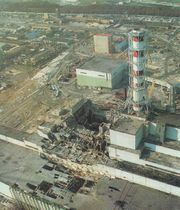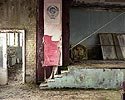 Today marks the 20th anniversary of the Chernobyl disaster, the worst nuclear power accident in the history of mankind. Conservative estimates approximate the death toll to be around 93,000 people. The amount of radiation released was over 400 times higher than the 1945 atomic bomb detonated over Hiroshima that ended World War II.
Today marks the 20th anniversary of the Chernobyl disaster, the worst nuclear power accident in the history of mankind. Conservative estimates approximate the death toll to be around 93,000 people. The amount of radiation released was over 400 times higher than the 1945 atomic bomb detonated over Hiroshima that ended World War II.In university, I had the privilege of studying photography under Professor David McMillan. David has spent over a decade photographing the area around Chernobyl. Rather than describe the intentions behind his work, I'll let him speak for himself.
In 1994, eight years after the accident, I read a magazine article describing the condition of the area, which became known as the exclusion zone. Many of the artifacts of the citizenry were left behind, and thousands of acres of formerly productive farmland were left to lie fallow. My photographic interests had long been in the relationship between nature and culture, so the subject seemed very rich in possibilities. I was intrigued enough to arrange a visit, and in October of 1994, I went to photograph the exclusion zone for the first time.
I soon realized that the city of Pripyat, where the employees of the nuclear power plant and their families once lived, was where my real interests lay. The Atomic City, as it was once known, was considered one of the finest places to live in the former Soviet Union. The first apartments were built in the mid-seventies, when the power plant was under construction, and at the time of the accident, it was home to 45,000 people. There were all the amenities of a modern Soviet city, with many schools, stores, hospitals, and recreational and cultural facilities. It is now uninhabitable and will never be lived in again.
Read the full artist's statement here.
I'm going to post a few of the images that speak most to me, although these digital images really don't do the work justice. If you ever get the chance to see these images in person, do yourself a favour and spend some time with them. I'll announce any local exhibits that I'm aware of here.
Trees growing through the floors of buildings. Cribs that will never hold life again. Toys abandoned. Despite the man-made tragedy that has affected these items, nature is beginning to reclaim all. Chernobyl, as seen through David's eyes, is both mesmerizing and haunting. Beautiful and terrifying. Distant, yet familiar. In David's words:
The exclusion zone is a remarkable and surprising place, not dead and static, as one would expect, but full of growth and change.
Time to let the work speak for itself! All of David's photographs can be found on his website, Pripyat and the 30K Zone.
Click on a thumbnail below to see a full sized image.
Currently playing - U2 - Until the End of the World
Now entering my thirteenth Cola free day!
An interesting side note. Chernobyl is Ukrainian for "Mugwort", also known as "Wormwood". Some people believe that the Chernobyl accident was prophesied in the Bible's Book of Revelations:
And the third angel sounded, and there fell a great star from heaven, burning as it were a lamp, and it fell upon the third part of the rivers, and upon the fountains of waters; and the name of the star is called Wormwood: and the third part of the waters became wormwood; and many men died of the waters, because they were made bitter. — Revelation 8:10-11


















1 comment:
Hello there my name is alex, and i would say something about this photoprojekt and David McMillan in my photoclass,
woul you be so nice and can you give me please some mor information about David, because i cant find it anywhere :)
with best wishes from vienna
alex.
P.S:my email : gnatyk@gmail.com
Post a Comment